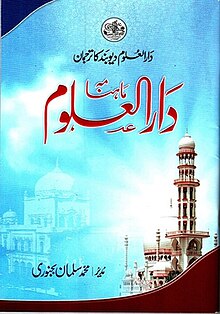

 | |

November–December 2023 cover
| |
| Editor | Salman Bijnori |
|---|---|
| Former editors | Azhar Shah Qaiser |
| Categories | Theology, Culture, Dawah, Literature, Deobandi movement |
| Frequency | Monthly |
| Publisher | Darul Uloom Deoband |
| Founder | Muhammad Tayyib Qasmi |
| First issue | May–June 1941 |
| Country | India |
| Based in | Deoband |
| Language | Urdu |
| Website | darululoom-deoband.com |
Monthly Darul Uloom (Urdu: ماہنامہ دارالعلوم) is an Urdu magazine published by Darul Uloom Deoband since 1941.[1] Inaugurated under the supervision of Muhammad Tayyib Qasmi, with Abdul Wahid Ghazipuri as the initial editor, the magazine is currently edited by Salman Bijnori, guided by Abul Qasim Nomani. Comprising articles primarily authored by faculty members or alumni,[2] the publication extends its focus beyond the reformation of the nation and the Muslim community. It covers a range of topics, including current religious, intellectual, social, and political issues, providing readers with insights into contemporary events and situations while also alerting Muslims to the challenges they may encounter.[3] The magazine holds a distinct journalistic perspective on key issues related to the Deobandi movement.[4] Though it faced cessation in the late 1940s, it was later revived by Azhar Shah Qaiser. Under his three-decade editorship, it evolved into a multidimensional publication,[5] leaving a lasting legacy evident in the influence it exerted on other educational institutions, inspiring the creation of magazines such as Bayyināt that follow its model.[6]
Over sixteen years, Darul Uloom Deoband initiated the launch of a new monthly Urdu magazine following the demise of Al-Qasim and Al-Rashid.[7] Guided by Muhammad Tayyib Qasmi and edited by Abdul Wahid Ghazipuri, the institution unveiled its inaugural issue in May-June 1941.[7] Ghazipuri served as the editor until 1944, later separating from Monthly Darul Uloom and relocating to Delhi. Qazi Khaliq Ahmad assumed the editorship but, facing time constraints, relinquished the position in 1948.[8]
In 1949, Abdul Hafeez Balyawi took over as editor, but financial constraints led to the publication of only seven issues during his tenure.[8] Monthly Darul Uloom transformed into a quarterly publication in the latter part of 1949, shedding its scholarly status and adopting a promotional brochure format under Azhar Shah Qaiser's oversight.[8] After a hiatus, the magazine resumed its monthly schedule in April 1951 under Qaiser's editorship,[9] continuing until 1982.[10] Under his editorship, his influential connections brought numerous scholars, writers, poets, and journalists to the magazine, such as Zafeeruddin Miftahi and, briefly, Nadeem al-Wajidi, playing a role in its success with a comprehensive and versatile range of content.[9]
Following Azhar Shah Qaiser, Riyasat Ali Zafar Bijnori assumed the editorship,[10] succeeded later by Habibur Rahman Azmi, who held the position from October 1984 to November 2016.[11] Nayab Hasan Qasmi notes that throughout Azmi's tenure, the magazine not only retained its former glory but also experienced significant growth, expanding its readership beyond India into other Asian countries.[10] Salman Bijnori took over as the seventh editor after Azmi's passing.[11]
Darul Uloom Deoband has an office for managing Monthly Darul Uloom, published online on the institution's website for several years.[12] Permanent writers to the magazine include Shabbir Ahmad Usmani, Ahmad Saeed Dehlavi, Muhammad Tayyib Qasmi, Izaz Ali Amrohi, Hifzur Rahman Seoharwi, Muhammad Shafi Deobandi, Saeed Ahmad Akbarabadi, Muhammad Miyan Deobandi, Idris Kandhlawi, Yusuf Banuri, Manazir Ahsan Gilani, Manzoor Nomani, and Habibur Rahman Azmi.[13]
The Monthly Darul Uloom begins with an editorial section titled『Rashhāt,』focusing on religious and theological analyses alongside commentary on national and global issues. The magazine features articles from national and international researchers. The final pages highlight the recent travels of Darul Uloom Deoband's head under the title "Darul Uloom."[13]
Azhar Shah Qaiser's writings, titled "Harf-e-Aghaz," cover academic, intellectual, research, literary, and political issues. Writing from Zafeeruddin Miftahi and occasionally Nadim Al-Wajdi are also included. The "Adabiyyat" section consistently showcases ghazals from poets like Mahir ul Qadri, Jigar Moradabadi, and others.[9]
Every month, the criticism and commentary column presents reviews for new books by various authors, addressing multiple releases concurrently. Alongside Azhar Shah Qaiser, writers like Anzar Shah Kashmiri, Abdul Rauf Aali, and Qamar Ahmed Usmani engage in commentary writing, with Aali and Usmani receiving recognition from the Urdu Academy for their writings.[9]
Under Azhar Shah Qaiser's editorship, the Monthly Darul Uloom becomes a comprehensive publication, covering academic, religious, literary, and critical topics for a diverse audience.[5] Habibur Rahman Azmi's column, "Nigarishat Ka Column," features creations from scholars and writers, while his articles in the Monthly Darul Uloom are compiled into a three-volume series titled "Maqalat-e-Habib," have received acclaim in academic circles.[10]
In its inaugural edition, the editor of Monthly Darul Uloom delineated the magazine's objectives.[7] The publication aims to present divine sciences and prophetic teachings in an accessible manner, transcending social classes.[14] Its mission includes clarifying the principles of Islam, investigating Islamic theology, and presenting clear responses to historical events and arguments from both contemporary and historical critics of Islam. It works to highlight the aesthetic aspects of the faith, engaging both allies and adversaries in developing a religious mindset among Muslims in the current era of disbelief and irreligiosity.[14] Emphasizing legal matters within the Islamic framework,[3] the magazine only features writings from within the Islamic faith, excluding writers from other religions or rites.[2]
It has received diverse academic responses. Wasim Ahmad from Jamia Hamdard notes its responsiveness to assumed Muslim needs, albeit with a focus on specific concerns.[2] Delhi University's PhD scholar, Muhammad Sirajullah, commends its high standards and occasional linguistic complexity.[3] Mohammad Moosa, a PhD scholar from Panjab University, emphasizes the magazine's commitment to informing the Muslim community on a broad spectrum of issues.[15] Nayab Hasan Qasmi, author of Darul Uloom Deoband Ka Sahafati Manzarnama, acknowledges the magazine's significant contribution to Islamic journalism.[13] Muhammadullah Qasmi, a PhD scholar from Jamia Hamdard appreciates the publication's diversity, covering scholarly, reformative, and thought-provoking content on religious, political, and administrative topics.[12]